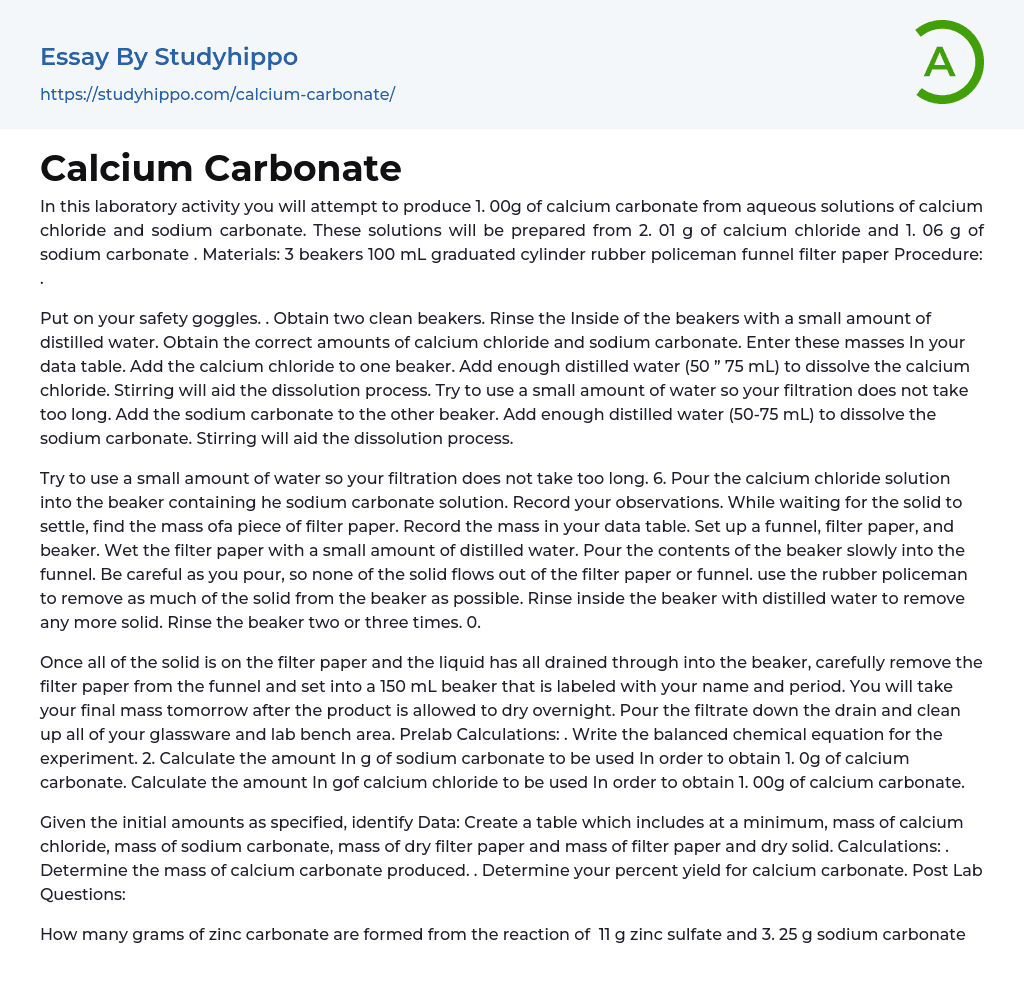In this laboratory activity you will attempt to produce 1. 00g of calcium carbonate from aqueous solutions of calcium chloride and sodium carbonate. These solutions will be prepared from 2. 01 g of calcium chloride and 1. 06 g of sodium carbonate . Materials: 3 beakers 100 mL graduated cylinder rubber policeman funnel filter paper Procedure: .
Put on your safety goggles. . Obtain two clean beakers. Rinse the Inside of the beakers with a small amount of distilled water. Obtain the correct amounts of calcium chloride and sodium carbonate. Enter these masses In your data table. Add the calcium chloride to one beaker. Add enough distilled water (50 ” 75 mL) to dissolve the calcium chloride. Stirring will aid the dissolution process. Try to use a small amount of water so your
...filtration does not take too long. Add the sodium carbonate to the other beaker. Add enough distilled water (50-75 mL) to dissolve the sodium carbonate. Stirring will aid the dissolution process.
Try to use a small amount of water so your filtration does not take too long. 6. Pour the calcium chloride solution into the beaker containing he sodium carbonate solution. Record your observations. While waiting for the solid to settle, find the mass ofa piece of filter paper. Record the mass in your data table. Set up a funnel, filter paper, and beaker. Wet the filter paper with a small amount of distilled water. Pour the contents of the beaker slowly into the funnel. Be careful as you pour, so none of the solid flows out of the filter paper or funnel. use the rubber policeman to remove as much of th
solid from the beaker as possible. Rinse inside the beaker with distilled water to remove any more solid. Rinse the beaker two or three times. 0.
Once all of the solid is on the filter paper and the liquid has all drained through into the beaker, carefully remove the filter paper from the funnel and set into a 150 mL beaker that is labeled with your name and period. You will take your final mass tomorrow after the product is allowed to dry overnight. Pour the filtrate down the drain and clean up all of your glassware and lab bench area. Prelab Calculations: . Write the balanced chemical equation for the experiment. 2. Calculate the amount In g of sodium carbonate to be used In order to obtain 1. 0g of calcium carbonate. Calculate the amount In gof calcium chloride to be used In order to obtain 1. 00g of calcium carbonate.
Given the initial amounts as specified, identify Data: Create a table which includes at a minimum, mass of calcium chloride, mass of sodium carbonate, mass of dry filter paper and mass of filter paper and dry solid. Calculations: . Determine the mass of calcium carbonate produced. . Determine your percent yield for calcium carbonate. Post Lab Questions:
How many grams of zinc carbonate are formed from the reaction of 11 g zinc sulfate and 3. 25 g sodium carbonate
- Bottled Water essays
- John Locke essays
- 9/11 essays
- A Good Teacher essays
- A Healthy Diet essays
- A Modest Proposal essays
- A&P essays
- Academic Achievement essays
- Achievement essays
- Achieving goals essays
- Admission essays
- Advantages And Disadvantages Of Internet essays
- Alcoholic drinks essays
- Ammonia essays
- Analytical essays
- Ancient Olympic Games essays
- APA essays
- Arabian Peninsula essays
- Argument essays
- Argumentative essays
- Art essays
- Atlantic Ocean essays
- Auto-ethnography essays
- Autobiography essays
- Ballad essays
- Batman essays
- Binge Eating essays
- Black Power Movement essays
- Blogger essays
- Body Mass Index essays
- Book I Want a Wife essays
- Boycott essays
- Breastfeeding essays
- Bulimia Nervosa essays
- Business essays
- Business Process essays
- Canterbury essays
- Carbonate essays
- Catalina de Erauso essays
- Cause and Effect essays
- Cesar Chavez essays
- Character Analysis essays
- Chemical Compound essays
- Chemical Element essays
- Chemical Substance essays
- Cherokee essays
- Cherry essays
- Childhood Obesity essays
- Chlorine essays
- Classification essays




